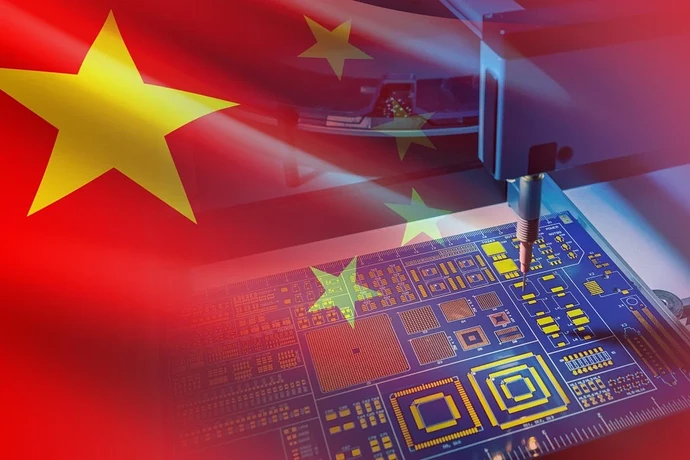Executive Summary
China’s ambition to triple its artificial intelligence (AI) chip production by 2026, as reported by the Financial Times, marks a significant escalation in its pursuit of technological self-reliance amid intensifying U.S.-China tech competition. Driven by U.S. export controls and a national strategy prioritizing “independent and controllable” AI capabilities, China is leveraging state-backed investments, domestic foundries, and companies like Huawei to bolster its semiconductor industry. This report examines China’s strategy, focusing on the interplay of hardware and software integration, key players, manufacturing challenges, and the geopolitical and economic implications of this push. While China has made notable strides in chip design and domestic AI ecosystems, limitations in advanced manufacturing and global supply chain access pose significant hurdles. The report adopts a neutral, third-party perspective, drawing on recent developments and credible sources to analyze this pivotal moment in the global AI race.
1. Introduction: China’s AI Chip Ambitions in Context
China’s drive to triple AI chip production by 2026 reflects a broader national strategy to achieve self-sufficiency in critical technologies, spurred by U.S. export controls aimed at curbing its AI and semiconductor advancements. The Financial Times reported on August 27, 2025, that Chinese fabrication plants, particularly those tied to Huawei, are set to significantly increase output, with three new foundries expected to rival or surpass the production capacity of Semiconductor Manufacturing International Corporation (SMIC), China’s leading foundry.
This move aligns with China’s “Made in China 2025” initiative and the “Delete America” policy, which seek to reduce reliance on foreign technology and establish dominance in AI and semiconductors. The U.S.-China tech rivalry has intensified since 2018, with U.S. policies targeting advanced chip exports and manufacturing equipment to slow China’s technological progress. Despite these restrictions, China’s government has allocated substantial resources—over ¥340 billion ($47 billion) through the National Integrated Circuit Industry Investment Fund (Big Fund) in its third phase—to support domestic semiconductor production and AI development. This report explores the strategies, challenges, and implications of China’s efforts, emphasizing the critical role of “hard-soft integration” in building a competitive AI ecosystem.
2. The U.S.-China Tech Competition: Hardware and Software Dynamics
2.1 U.S. Export Controls and Strategic Objectives
The U.S. has implemented stringent export controls since 2022 to limit China’s access to advanced semiconductors (14nm and below) and critical manufacturing equipment, such as extreme ultraviolet (EUV) lithography machines from Dutch firm ASML. These measures, enforced by the U.S. Bureau of Industry and Security (BIS), aim to hinder China’s AI industry by restricting the hardware foundation—AI chips and data centers—essential for training and deploying large language models (LLMs).
In April 2025, the Trump administration tightened restrictions, imposing a licensing requirement with a presumption of denial on Nvidia’s H20 chips, which were designed for the Chinese market. The closure of loopholes, such as the Validated End-User (VEU) program that previously allowed foreign firms like Samsung and SK Hynix to produce advanced chips in China, has further strained China’s supply chain. These policies reflect a U.S. strategy to maintain technological supremacy by limiting China’s ability to scale advanced AI infrastructure, which is seen as a national security priority.
2.2 China’s Response: Building a Domestic AI Ecosystem
Despite these constraints, China has demonstrated resilience in developing its AI capabilities. Chinese firms like DeepSeek and Alibaba have made significant progress in LLMs, with DeepSeek adopting FP8 data formats tailored for domestic chips, signaling advancements in software optimization.
Companies such as Baidu have shifted procurement to domestic alternatives, exemplified by a ¥450 million order for 1,600 Huawei Ascend 910B chips in 2023 to insulate against U.S. sanctions. China’s strategy hinges on integrating hardware and software ecosystems to create efficient AI systems. This “hard-soft integration” involves designing chips that are optimized for domestic LLMs and software frameworks, reducing dependency on foreign platforms like Nvidia’s CUDA. For instance, Huawei’s Ascend 910C chip is paired with improved software to enhance developer accessibility, narrowing the gap with Nvidia’s offerings. Alibaba’s development of custom chips for cost reduction and efficiency further illustrates this trend.
3. China’s Domestic Semiconductor Industry: Progress and Challenges
3.1 Key Players and New Foundries
Huawei, through its chip design arm HiSilicon, is central to China’s AI chip ambitions, collaborating closely with SMIC, the country’s most advanced foundry capable of producing 7nm chips. The Financial Times report highlights three new foundries dedicated to Huawei’s AI chips, potentially surpassing SMIC’s current output of approximately 30,000 wafers per month (WPM). While specific details about these foundries’ locations and ownership remain undisclosed, speculation suggests they may involve partnerships with local governments in Shenzhen, possibly under the “Shenzhen three brothers” framework to circumvent direct U.S. sanctions. Other players, such as Cambricon, Biren Technology, and Enflame, are also gaining traction. Cambricon reported a 40-fold revenue surge in Q1 2025, driven by demand from firms like ByteDance, while SMIC plans to double its 7nm production capacity in 2026. These developments indicate a broadening of China’s domestic chip ecosystem, supported by significant government investment and a growing pool of talent, including engineers trained at global leaders like Nvidia and AMD.
3.2 Manufacturing Challenges
China’s semiconductor industry faces significant hurdles in advanced manufacturing. U.S. and allied export controls have blocked access to EUV lithography machines, forcing SMIC to rely on older deep ultraviolet (DUV) technology, which results in lower yields (reportedly 20–40% compared to an ideal 90%) and higher costs for advanced chips. SMIC’s 7nm process, used for Huawei’s Ascend 910B and Kirin 9000s chips, represents a breakthrough but is not yet economically viable for mass production due to these limitations.
Additionally, China struggles with bottlenecks in high-bandwidth memory (HBM) and advanced packaging, critical for AI chip performance. While Huawei has accessed HBM stockpiles from Samsung, domestic alternatives are still developing, with firms like Wuhan Xinxin Semiconductor Manufacturing working on HBM production. The lack of access to cutting-edge equipment and software tools, such as electronic design automation (EDA) software for advanced chip design, further complicates scaling production.
3.3 Production Capacity and Yield Issues
SMIC’s current 7nm production capacity is constrained, with estimates suggesting Huawei can produce only 200,000 AI chips annually, far below domestic demand. The new foundries aim to address this gap, but their initial output is expected to be modest. Reports indicate SMIC’s yield rates remain low, with some sources disputing claims of improvement from 20% to 40% in early 2025. These challenges underscore the difficulty of achieving cost-effective, high-volume production without access to advanced global supply chains.
4. Hard-Soft Integration: A Strategic Imperative
China’s focus on “hard-soft integration” is a cornerstone of its AI strategy. By aligning domestic chip designs with software frameworks and LLMs, China aims to create a cohesive ecosystem that maximizes efficiency. Huawei’s Ascend series, for example, is being optimized with its CANN software to rival Nvidia’s CUDA, while Alibaba and DeepSeek are developing RISC-V-based CPUs and FP8-compatible models.
This integration enables Chinese firms to train LLMs on mixed hardware configurations, mitigating the impact of limited chip availability. The trend is evident in corporate strategies. Baidu’s shift to Huawei chips and Alibaba’s custom chip development reflect a broader move toward self-reliance, driven by geopolitical necessity. However, software maturity remains a challenge, as Chinese firms lack the depth of Nvidia’s ecosystem, and hiring sufficient software engineers to support AI hardware acceleration is a bottleneck.
5. Geopolitical and Economic Implications
5.1 Impact on Global Semiconductor Markets
China’s push for AI chip self-reliance is reshaping the global semiconductor landscape. U.S. firms like Nvidia face revenue losses, with estimates suggesting $16 billion in H20 chip sales to China in 2025 before restrictions tightened. Conversely, Chinese firms like Huawei and Cambricon are gaining market share, with projections indicating China’s domestic AI chip market could grow from 17% in 2023 to 55% by 2027. However, China’s reliance on foreign components, such as HBM from Korea and equipment from the U.S., Netherlands, and Japan, persists. Workarounds, including smuggling and shell companies, have allowed Huawei to access some restricted technology, but these are not sustainable for large-scale production.
5.2 Risks of Overcapacity and “Involution”
A potential risk for China is overcapacity, or “involution,” where domestic production exceeds demand, leading to intense competition and financial strain. If Chinese chips cannot be sold internationally due to sanctions or lack of competitiveness, firms may face price wars and reduced profitability. This risk is compounded by the high costs of subsidizing low-yield production, as seen in SMIC’s 7nm process.
5.3 Geopolitical Stakes
The U.S.-China tech race is a struggle for technological and economic dominance. China’s progress in AI chips threatens U.S. leadership, particularly if Huawei and SMIC close the performance gap with Nvidia. Conversely, U.S. policies risk alienating allies and damaging American firms, as seen in lobbying efforts by Nvidia’s Jensen Huang to ease restrictions. China’s retaliatory measures, such as rare earth export controls and tariffs, further fragment the global supply chain, creating parallel ecosystems with reduced interoperability.
6. Future Outlook and Challenges
China’s goal to triple AI chip production by 2026 is ambitious but faces significant challenges. Key hurdles include: Technological Gaps: While China has advanced in chip design, manufacturing at 5nm or below remains elusive without EUV lithography. Experts estimate China is 5–10 years behind global leaders like TSMC. Global Supply Chain Dependency: Continued reliance on foreign equipment and components limits scalability. Efforts to develop domestic alternatives, such as SiCarrier’s lithography tools, are nascent. Talent and Software Ecosystem: Scaling software development to match hardware advancements requires significant investment in talent and infrastructure.
Geopolitical Risks: Escalating U.S. sanctions and potential responses from allies like Japan and the Netherlands could further restrict China’s access to critical technologies. Despite these challenges, China’s state-backed model and domestic market size provide a strong foundation for growth. The success of Huawei’s Ascend series and SMIC’s 7nm production demonstrates resilience, and the integration of domestic chips with LLMs positions China to compete in AI applications. However, achieving global competitiveness will require overcoming manufacturing bottlenecks and navigating geopolitical constraints.
7. Conclusion
China’s plan to triple AI chip production by 2026 is a bold step toward technological self-reliance, driven by U.S. export controls and a national imperative to lead in AI. Huawei, SMIC, and emerging players like Cambricon are at the forefront, supported by massive state investment and a focus on “hard-soft integration.”
While significant progress has been made, challenges in advanced manufacturing, yield rates, and global supply chain access persist. The outcome of this push will shape the U.S.-China tech race, with implications for global markets, innovation, and geopolitical power dynamics. For now, China’s trajectory suggests a narrowing gap with the West, but sustained investment and strategic agility will be critical to realizing its ambitions.









